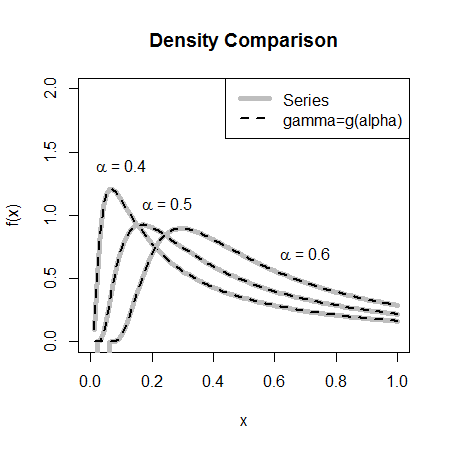The short answer is that your $\delta$ is fine, but your $\gamma$ is wrong. In order to get the positive stable distribution given by your formula in R, you need to set
$$
\gamma = |1 - i \tan \left(\pi \alpha / 2\right)|^{-1/\alpha}.
$$
The earliest example I could find of the formula you gave was in (Feller, 1971), but I've only found that book in physical form. However (Hougaard, 1986) gives the same formula, along with the Laplace transform
$$
\mathrm{L}(s) = \mathrm{E}\left[\exp(-sX)\right] = \exp\left(-s^\alpha\right).
$$
From the stabledist manual (stabledist is used in fBasics), the pm=1 parameterization is from (Samorodnitsky and Taqqu, 1994), another resource whose online reproduction has eluded me. However (Weron, 2001) gives the characteristic function in Samorodnitsky and Taqqu's parameterization for $\alpha \neq 1$ to be
$$
\varphi(t) = \mathrm{E}\left[\exp(i t X) \right] = \exp\left[i \delta t - \gamma^\alpha |t|^\alpha \left(1 - i \beta \mathrm{sign}(t) \tan{\frac{\pi \alpha}{2}} \right) \right].
$$
I've renamed some parameters from Weron's paper to coinside with the notation we're using. He uses $\mu$ for $\delta$ and $\sigma$ for $\gamma$. In any case, plugging in $\beta=1$ and $\delta=0$, we get
$$
\varphi(t) = \exp\left[-\gamma^\alpha |t|^\alpha \left(1 - i \mathrm{sign}(t) \tan \frac{\pi \alpha}{2} \right) \right].
$$
Note that $(1 - i \tan (\pi \alpha / 2)) / |1 - i \tan(\pi \alpha / 2)| = \exp(-i \pi \alpha / 2)$ for $\alpha \in (0, 1)$ and that $i^\alpha = \exp(i \pi \alpha / 2)$. Formally, $\mathrm{L}(s)=\varphi(is)$, so by setting $\gamma = |1 - i \tan \left(\pi \alpha / 2\right)|^{-1/\alpha}$ in $\varphi(t)$ we get
$$
\varphi(is) = \exp\left(-s^\alpha\right) = \mathrm{L}(s).
$$
One interesting point to note is that the $\gamma$ that corresponds to $\alpha=1/2$ is also $1/2$, so if you were to try $\gamma=\alpha$ or $\gamma=1-\alpha$, which is actually not a bad approximation, you end up exactly correct for $\alpha=1/2$.
Here's an example in R to check correctness:
library(stabledist)
# Series representation of the density
PSf <- function(x, alpha, K) {
k <- 1:K
return(
-1 / (pi * x) * sum(
gamma(k * alpha + 1) / factorial(k) *
(-x ^ (-alpha)) ^ k * sin(alpha * k * pi)
)
)
}
# Derived expression for gamma
g <- function(a) {
iu <- complex(real=0, imaginary=1)
return(abs(1 - iu * tan(pi * a / 2)) ^ (-1 / a))
}
x=(1:100)/100
plot(0, xlim=c(0, 1), ylim=c(0, 2), pch='',
xlab='x', ylab='f(x)', main="Density Comparison")
legend('topright', legend=c('Series', 'gamma=g(alpha)'),
lty=c(1, 2), col=c('gray', 'black'),
lwd=c(5, 2))
text(x=c(0.1, 0.25, 0.7), y=c(1.4, 1.1, 0.7),
labels=c(expression(paste(alpha, " = 0.4")),
expression(paste(alpha, " = 0.5")),
expression(paste(alpha, " = 0.6"))))
for(a in seq(0.4, 0.6, by=0.1)) {
y <- vapply(x, PSf, FUN.VALUE=1, alpha=a, K=100)
lines(x, y, col="gray", lwd=5, lty=1)
lines(x, dstable(x, alpha=a, beta=1, gamma=g(a), delta=0, pm=1),
col="black", lwd=2, lty=2)
}
$\hskip1in$

- Feller, W. (1971). An Introduction to Probability Theory and Its Applications, 2, 2nd ed. New York: Wiley.
- Hougaard, P. (1986). Survival Models for Heterogeneous Populations Derived from Stable Distributions, Biometrika 73, 387-396.
- Samorodnitsky, G., Taqqu, M.S. (1994). Stable Non-Gaussian Random Processes, Chapman & Hall, New York, 1994.
- Weron, R. (2001). Levy-stable distributions revisited: tail index > 2 does not exclude the Levy-stable regime, International Journal of Modern Physics C, 2001, 12(2), 209-223.

